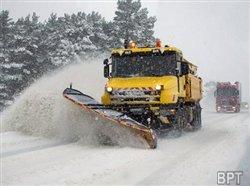Snow-fighters keep roads clear and save lives
(BPT) - Snow and ice affect more than 70 percent of the U.S. population, according to the Federal Highway Administration. Each winter the average driver in these areas will see more than five inches of snow on the roads. And when the snow is falling there are few things more comforting than the sight of snow plows and salt trucks making highways safe for commuters, shoppers and travelers.
In the Snow Belt, citizens expect roads to always be cleared of snow and ice, no matter how bad the storm, says Bret Hodne, public works director for West Des Moines, Iowa. To help meet those sky-high expectations, Hodne orders salt months before the first snowflake falls. His motto is "don't trust your climate," because if you plan for an average season it's bound to be a record-setting winter of snow and ice.
Snowfighters first began using salt in the 1930s for snow and ice control, but it wasn’t until the 1960s that salt became widely adapted as one of the major weapons to keep winter roads safe. In an average Iowa winter, Hodne's department alone uses 4,000 tons of salt and keeps twice that amount in storage.
Salt works by lowering the freezing point of water, and when applied on already-frozen roadways (de-icing) it helps to melt the ice. When salt is applied before a freeze sets in (anti-icing) it helps prevent liquid water from becoming ice. This is why drivers will often see salt trucks out and about before the roads start to freeze.
Both methods give tires more traction with the pavement, keeping roads open and safe while protecting lives and commerce. How quickly salt melts frozen water depends upon a number of variables, including temperature, time and the rate of application. Fortunately, it is usually not necessary to melt all the snow and ice on a road. Merely destroying or preventing the bond between pavement and frozen water is a more efficient, economical and environmentally sensitive approach. In fact, salt is the single most effective and economical method for treating roadways.
According to the Federal Highway Administration, snowy, slushy or icy pavement accounts for more than 116,000 Americans injured and more than 1,300 killed on each year. In fact, 24 percent of all weather-related vehicle crashes occur under such wintry conditions. A study by Marquette University found that effective use of road salt reduced vehicle crashes by 88 percent, injuries by 85 percent and the cost of accidents by 85 percent.
Icy road conditions are not limited to northern states, however. Sudden and unexpected snow storm and freezing rain can affect southern states as well. In January 2011, such a snowstorm hit Atlanta covering roadways in a sheet of ice and shutting down routine business and traffic for five days. In response, Bill Shelton, road maintenance division manager of suburban Cobb County, has implemented a distribution system that gets salt from storage to roads as quickly as possible. Instead of storing salt and sand in just one location, Shelton has spread it out to five spots throughout the county for easier access to its 2,500 miles of roads.
Snow-fighters have several safety tips for winter drivers. The most important is if you can avoid driving, it is best to stay off the roads -- at least until the snow plows and salt trucks have had a chance to do their job. It is also best not to pass road-clearing trucks. Drivers will also want to make sure they have tires with good traction, cleared windows and headlights with properly working windshield wipers and anti-icing fluid in order to see and be seen, and to leave a good amount of space between their vehicle and the one in front. Finally, remember that taking your time and driving safely is more likely to get you to your destination. For more information please visit www.safewinterroads.org.







